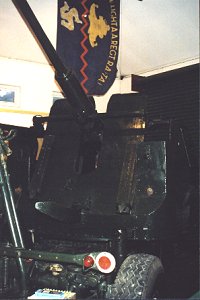Patrons:
Air Marshal Sir Ian Macfadyen
The Lieutenant Governor, His Excellency Lieutenant General Sir John Lorimer KCB DSO MBE
Bofors Guns
 The gun that used to be on display in the museum, was a 40 millimetre BOFORS of 1957 vintage, and was presented by the Ministry of Defence to the Old Comrades Association of the 15th (Isle of Man) Light Anti Aircraft Territorial Regiment of the Royal Artillery for use as a museum piece. Weighing almost 5 tonnes, it was 25 feet long from Muzzle to tow bar and on its wheels in the towing position was 7 feet wide power control. Its ammunition, 40 millimetre, 2lb weight high explosive shells were fused to explode on impact but to allow for mis-hitting a target, can be set to self-destruct at either 11 or 17 seconds. With an opening range of 2,000 yards, its rate of fire was 240 shells per minute at a muzzle velocity of some 3,800 feet per second. It was, however, a much later development than the Bofors gun of World War II as operated by the Manx Regiment – it was in every sense a very much bigger and heavier piece of artillery than the earlier war-time models.
The gun that used to be on display in the museum, was a 40 millimetre BOFORS of 1957 vintage, and was presented by the Ministry of Defence to the Old Comrades Association of the 15th (Isle of Man) Light Anti Aircraft Territorial Regiment of the Royal Artillery for use as a museum piece. Weighing almost 5 tonnes, it was 25 feet long from Muzzle to tow bar and on its wheels in the towing position was 7 feet wide power control. Its ammunition, 40 millimetre, 2lb weight high explosive shells were fused to explode on impact but to allow for mis-hitting a target, can be set to self-destruct at either 11 or 17 seconds. With an opening range of 2,000 yards, its rate of fire was 240 shells per minute at a muzzle velocity of some 3,800 feet per second. It was, however, a much later development than the Bofors gun of World War II as operated by the Manx Regiment – it was in every sense a very much bigger and heavier piece of artillery than the earlier war-time models.
During World War II Bofors guns played a vital role and in the hands of the Manx Regiment were operated not only as anti-aircraft weapons using the type of ammunition described above, but also as anti-tank guns with armour-piercing ammunition and in the final stages of the war in Europe, as enemy air attacks decreased, as light artillery against enemy infantry concentrating before counter attacks. These guns of World War II vintage, as shown below, had a rate of fire of 120 shells per minute and were operated by detachments of 7 men, each of whom was responsible for a specific duty. No. 1 was the detachment commander and he was responsible for the tactical control, the selection and identification of targets and was in command of the gun. Nos. 2 and 3 were the layers for line and elevation, No.4 loaded and fired the gun, Nos.5 and 6 were responsible for feeding ammunition to the loader and No.7 was the target spotter. Getting into action and operating the gun was therefore essentially a team effort.
 Armed with unprotected, manually operated and light-weight Bofors guns, the Manx Regiment saw action prior to and during the Battle of Britain and, after sailing from England in November 1940, experienced very active service overseas in Egypt, the Island of Crete, Eritrea, the North African deserts from El Alamein to Tunisia, Italy via Salerno for the first front in occupied Europe, and finally from the beaches of Normandy through France, Belgium and Holland to North-West Germany until the war in Europe ended.
Armed with unprotected, manually operated and light-weight Bofors guns, the Manx Regiment saw action prior to and during the Battle of Britain and, after sailing from England in November 1940, experienced very active service overseas in Egypt, the Island of Crete, Eritrea, the North African deserts from El Alamein to Tunisia, Italy via Salerno for the first front in occupied Europe, and finally from the beaches of Normandy through France, Belgium and Holland to North-West Germany until the war in Europe ended.
It is officially recorded that Bofors gun detachments of the Manx Regiment accounted for some 300 enemy aircraft destroyed and with its lengthy record of active service overseas, the Regiment is unrivalled by any other Light Anti-Aircraft Regiment in the annals of the Royal Artillery.
Copyright O.C.A. By kind permission of the O.C.A. Secretary.
